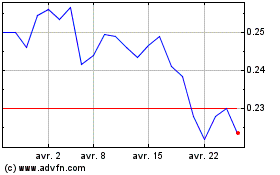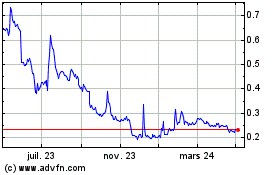SpineGuard's DSG® Technology Applied to Robotics: Podium Presentation of the Results at the Conference on New Technologies for Computer and Robot Assisted Surgery (CRAS)
18 Septembre 2023 - 6:00PM
Business Wire
CRAS, leading international conference on
robotic surgery
100% of the drillings stopped within a corridor
considered as clinically safe, which consists of 2 millimeters on
each side of the interface between bone and the spinal canal
Regulatory News:
SpineGuard (FR0011464452 – ALSGD), an innovative company
that deploys its DSG® (Dynamic Surgical Guidance) sensing
technology to secure and streamline the placement of bone implants,
announced that a research team presented an article at the CRAS
conference on September 12th in Paris, France. They report the
progress made with the robotic application of DSG.
Stéphane Bette, co-founder and Deputy CEO of SpineGuard,
said: "The acceptance of this new article in a reference conference
of the sector is a new validation by the scientific community of
the value and feasibility in using DSG to enhance surgical robots
in orthopedics. It also displays the richness of our collaboration
with ISIR and the hospital practitioners who contributed to this
study.”
Brahim Tamadazte, Research Director at CNRS and member of
ISIR (Sorbonne Université, CNRS UMR 7222, Inserm U1150), co-author
of the study, adds: “The tight collaboration between
SpineGuard, the Sorbonne Institute of Spine Surgery and ISIR
continuously allows for improving Spine Surgery. The know-how
combination of SpineGuard for DSG smart instruments with our
long-time expertise in surgical robotics and the experience of
renown spine surgeons such as Raphaël Vialle, Elie Saghbiny and
Christina Bobbio, enabled us to develop an algorithmic method for
detecting potential bone breaches during pedicle screw
insertion.”
Pr. Roger Widmann, Chief of the Pediatric Orthopedic Surgery,
Hospital for Special Surgery, New York, US, and Professor at Weill
Cornell Medical College, concludes: “The innovative and truly
unique aspect of DSG technology is that the electrical conductivity
data obtained from the tip of the DSG-enhanced surgical drills and
taps provides real-time position and guidance information from the
tip of traditional robotically navigated surgical instruments. DSG
data provides confirmatory secondary modality data and confirmation
regarding the 3D location of the instrument tip, and in doing so
can help prevent complications and errors related to loss of
registration or failure of traditional navigation before creation
of pilot hole or definitive screw placement.”
DSG is based on the local measurement of electrical conductivity
of tissues in real time without X-ray imaging, with a sensor
located at the tip of the drilling instrument. Its efficacy was
proven by more than 95,000 surgeries across the globe and 25
scientific publications. SpineGuard has entered in 2017 a
collaboration with the ISIR (Institut des Systèmes Intelligents et
de Robotique) lab of Sorbonne University, CNRS and INSERM, for the
application of DSG to surgical robots and the enhancement of their
safety, accuracy, and autonomy.
CRAS (Conference on New Technologies for Computer and Robot
Assisted Surgery) founded in 2011 has become one of the most
recognized scientific conferences in the field of robot assisted
surgery. Its goals are to strengthen the collaboration between the
different research groups to boost the efficacy and shorten the
development cycle, in a context where numerous technologies
applicable to robotics have not made their way into operating rooms
yet.
A clinically relevant configuration
As stated in our march press release, the experiment which
results were presented, consists in automatically stopping the
drill bit as the tip is aiming at the bone boundary during a
vertebral drilling performed autonomously by a robot. However, in
order to go further in the challenge and the demonstration of DSG
efficacy, the trajectory is now pedicular. It presents tangential
configurations perfectly matching delicate surgical situations
where the spinal canal protecting the spinal cord must be avoided,
and where the tip does not coast the bone surface in a
perpendicular way. The algorithm used for the detection was tuned
before the 50-drilling series was performed, and no adjustments or
calibrations are needed for each specimen. The ex vivo pig vertebra
validation model (butcher shop) does not involve any animal
sacrifice.
100% success, an indisputable result
100% of the drillings stopped within a corridor considered as
clinically safe, which consists of 2 millimeters on each side of
the interface between bone and the spinal canal. More precisely,
all drillings belonged to a -0.9mm/+1.4mm interval, with a mean
distance of 0.7mm. This was obtained although the drilling was
performed in a totally "blind" manner, with neither utilization of
pre-op nor intra-op imaging.
This study and described algorithms are the fruits of the
collaboration between SpineGuard and ISIR. Part of this work
received funding from the European Union’s Horizon 2020 research
and innovation program, in the context of the FAROS project
(Functional Accurate RObotic Surgery) under grant agreement No
101016985.
About SpineGuard®
Founded in 2009 in France and the USA by Pierre Jérôme and
Stéphane Bette, SpineGuard is an innovative company deploying its
proprietary radiation-free real time sensing technology DSG®
(Dynamic Surgical Guidance) to secure and streamline the placement
of implants in the skeleton. SpineGuard designs, develops and
markets medical devices that have been used in over 95,000 surgical
procedures worldwide. Twenty-five studies published in
peer-reviewed scientific journals have demonstrated the multiple
benefits DSG® offers to patients, surgeons, surgical staff and
hospitals. Building on these strong fundamentals and several
strategic partnerships, SpineGuard has expanded the scope of its
DSG® technology in innovative applications such as the « smart »
pedicle screw, the DSG Connect visualization and registration
interface, dental implantology and surgical robotics. DSG® was
co-invented by Maurice Bourlion, Ph.D., Ciaran Bolger, M.D., Ph.D.,
and Alain Vanquaethem, Biomedical Engineer. SpineGuard has engaged
in multiple ESG initiatives. For further information, visit
www.spineguard.com
Disclaimer
The SpineGuard securities may not be offered or sold in the
United States as they have not been and will not be registered
under the Securities Act or any United States state securities
laws, and SpineGuard does not intend to make a public offer of its
securities in the United States. This is an announcement and not a
prospectus, and the information contained herein does and shall not
constitute an offer to sell or the solicitation of an offer to buy,
nor shall there be any sale of the securities referred to herein in
the United States in which such offer, solicitation or sale would
be unlawful prior to registration or exemption from
registration.
View source
version on businesswire.com: https://www.businesswire.com/news/home/20230918043362/en/
SpineGuard Pierre Jérôme CEO & Chairman Tel: +33 1 45
18 45 19 p.jerome@spineguard.com
SpineGuard Anne-Charlotte Millard CFO Tel: +33 1 45 18 45
19 ac.millard@spineguard.com
NewCap Investor Relations & Financial Communication
Mathilde Bohin / Aurélie Manavarere Tel: +33 1 44 71 94 94
spineguard@newcap.eu
Spineguard (EU:ALSGD)
Graphique Historique de l'Action
De Mar 2024 à Avr 2024

Spineguard (EU:ALSGD)
Graphique Historique de l'Action
De Avr 2023 à Avr 2024
